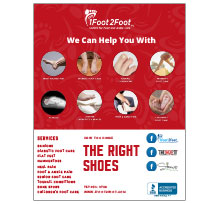Table of Contents
Introduction
Finding the Right Shoe
Several factors contribute to finding the right shoe. First, have your foot measured by a professional each time you shop for shoes. Your feet change as you age, often growing longer and wider. One important fact to take into consideration is that your feet swell during the day, so shoe shopping should take place in the later part of the day to compensate for the expansion. Make sure that the ball of your foot fits comfortably in the shoe and isn’t compressed. If necessary, ask for a wider width shoe to ensure a proper fit. Don’t buy a pair of shoes with the intention of “breaking them in”- the shoe should be comfortable and fit properly from the time of purchase. You can damage your feet in the time it takes you to wear the shoes down to a comfortable level.
Pick a shoe that is not too tight or too loose. An improper fit can cause the development of bunions, a painful bony growth on the side of your big toe, as well as callouses and ingrown toenails. Shoes with a narrow toe box can lead to the bones of the feet shifting over time, causing hammertoe, arch pain, and tendonitis. Also, keep in mind that sizes can vary between manufacturers, so go by your comfort level and not by what is on the size tag.
Look for a shoe that provides good heel and arch support. The heel and arch areas should be firm, but still flex when you walk. Make sure to try on both shoes, as it is not uncommon for your feet to differ in size. Allow for a half inch of space between your big toe and the end of the shoe. This allows your foot to move forward slightly as you walk. Without this space, you are prone to blisters from your foot rubbing on the inside of the shoe.
If you are diabetic, you may want to look into diabetic footwear. Diabetics are more prone to foot injuries, and it takes longer for these injuries to heal. Diabetic shoes have a wider toe box to allow more space in the shoe. This keeps the toes from rubbing together and causing blisters. Diabetic shoes also have thicker soles to cushion your feet better.
Finding properly fitting shoes is not difficult, it just takes a little time and patience. If you have concerns, a podiatrist can evaluate your foot type and direct you to a shoe that addresses your specific needs. Do your feet a favor and invest in a new pair of properly fitting shoes today.







